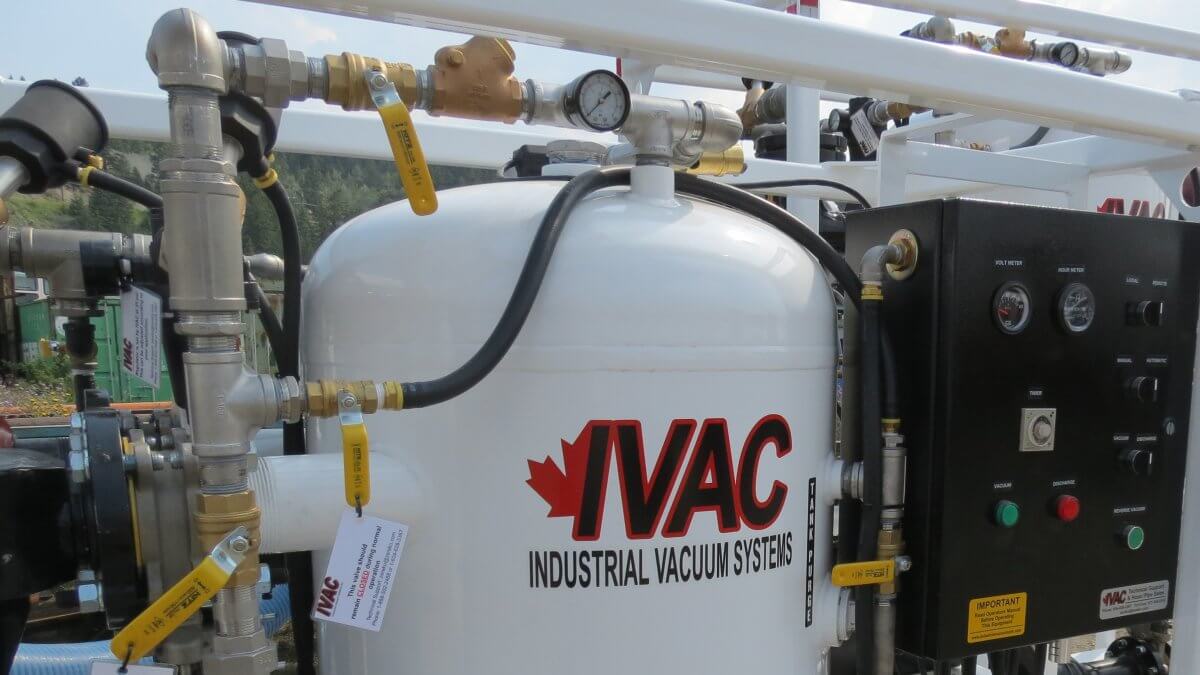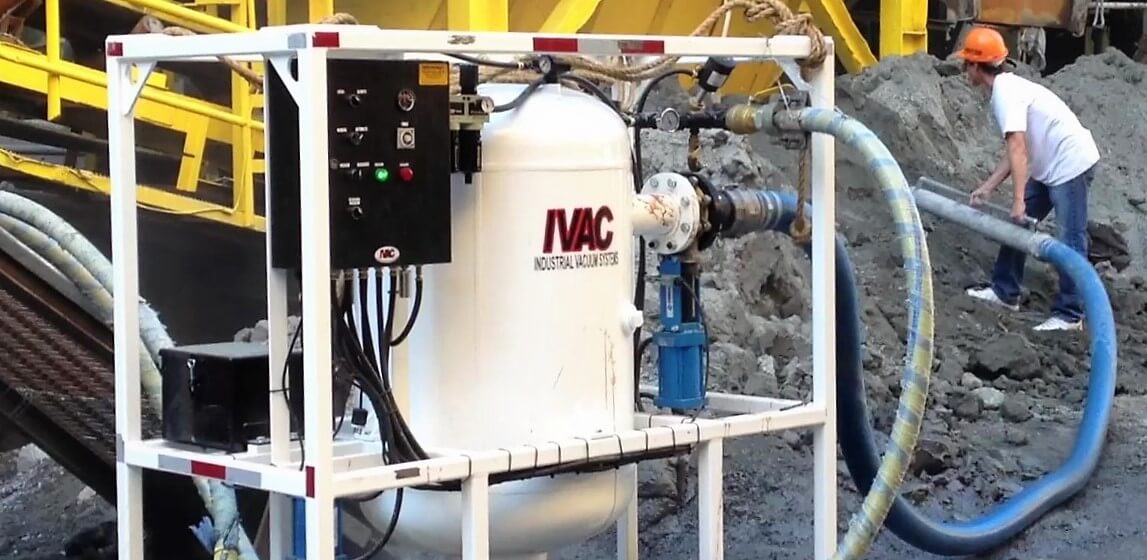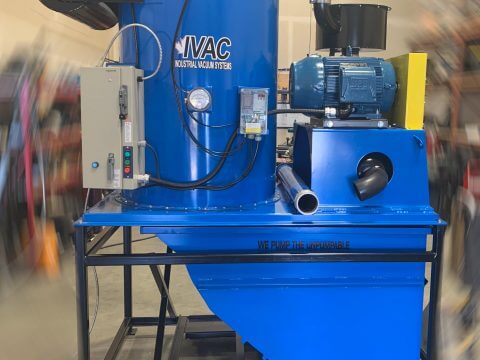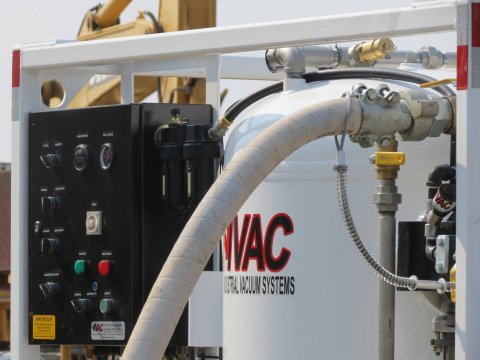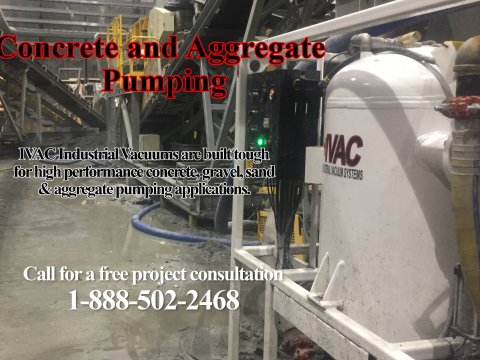COMPLETE GUIDE TO INDUSTRIAL VACUUM SYSTEMS
Industrial Vacuum System Definition
An industrial vacuum system is a piece of equipment used to transfer all kinds of materials either liquid or solid. Vacuum systems are used for a wide range of applications across many industries. The term “industrial vacuum” can sometimes be misleading, since what may be labeled a “vacuum system” can actually be a pump system or a configuration of the two. These heavy-duty industrial vacuum systems are designed to use vacuum and pressure to move different materials. A more accurate term would be “pneumatic conveyor system”, rather than “industrial vacuum”. The various choices and diversities in the pump and vacuum market can prove problematic for people when choosing the most effective system for their application. The following is a basic guide regarding industrial material transfer systems.
Pneumatic conveyor system
A pneumatic system refers to a piece of equipment being operated by pressurized air or gas. A pneumatic conveyor is a system in which bulk materials are moved through horizontal and vertical pipes from a source to a destination. Pneumatic conveying is the process of transferring material through either a pressure or vacuum system. A pressure system is known as a “positive condition” and a vacuum system is a “negative condition”. Traditionally, pneumatic conveyor systems include an input device, a conveying line and a discharge device.
The conveyor system uses either dilute phase or dense phase technology to transport the material. Dilute phase technology is a high-velocity system where the material being conveyed is continuously suspended in the air as it is pressured or vacuumed through a pipeline. Dense phase technology commonly refers to materials that move in relatively low velocities and are not air-borne in transit, these staggered amounts are called slugs.
Benefits of a pneumatic conveyor system
A pneumatic conveyance system has great flexibility. It can be designed to work in tandem with existing equipment. In addition, this pneumatic system takes up less space and provides more flexibility than the standard mechanical conveying systems. An additional benefit includes longer conveying distances. Also, the pneumatic convey stem has lower maintenance costs as it has fewer moving parts.
The enhanced safety that comes with less maintenance, less moving parts, less spillage, better sanitation and less noise is that the exposure to dangers are significantly reduced for operators. This can improve workplace conditions appreciably for employees. There is also less dust as the pneumatic conveyor system features enclosed pipeline which contains the dust better than the mechanical system. This enclosed pipeline reduces the risk of contamination, resulting in a cleaner workplace.
Industrial pump
An industrial pump is a heavy-duty piece of equipment that is used to move many different types of materials. These materials are transported by using some sort of mechanical action such as reciprocating or rotary impellers. Some of these materials being transported include food, water, chemicals, waste products, oil, sludge, slurry and gravel. However, the industrial pump has a multitude of applications beyond the examples given.
Pump classifications
Pumps are classified according to the method of displacement the pump uses to move material. Though there are many different types of pumps, they are commonly classified into two major groups: positive displacement and centrifugal.
Positive displacement pump
A positive displacement pump moves fluid or solids by trapping a fixed amount of that material and forcing it through a discharge pipe or discharge system. Some positive displacement pumps have an expanding cavity on the suction side and a decreasing cavity on the discharge side. What sets the positive displacement pump apart is the fact that it produces the same flow at a given speed (RPM) no matter how much the discharge pressure is. The pump will move the fluid at the same speed regardless of the pressure on the inlet end.
Centrifugal pump
A centrifugal pump uses an impeller to move fluid or other material through a chamber. The pump’s impeller rotates within the housing and reduces pressure at the inlet valve. This rotational mechanical energy transfers the fluid or other material to the discharge side of the impeller. Unlike positive displacement pumps, materials will not move at the same speed regardless of the pressure on the intake end. Due to the pump’s mode of operation, centrifugal pumps are also known as negative displacement pumps.
Basic Pump Types:
Jet Pump Venturi System
A jet pump operates on the principle of forcing a jet of steam, air, water or other fluid through a narrowed pipe causing a pressure differential. This pipe is commonly shaped like an hourglass. When the fluid flows through the constricted section of the pipe a resultant drop in pressure occurs. Then, as the shape of the pipe increases again the fluid velocity is increased. This hourglass-shaped pipe is called a venturi pipe. A common usage of the jet pump is for pumping well water, although this is not the only application for this type of pump.
The venturi effect
In industrial vacuum systems the principle of jetting fluid through a venturi pipe results in what is known as the “venturi effect”. The narrowing of the venturi pipe causes the speed of moving fluid to increase. This increase is similar to the pressure that can be created by partially plugging the end of a garden hose. This phenomenon results in a pressure decrease and a velocity increase as fluid is forced through a narrowed section of a pipe.
Liquid Ring Pump
A liquid ring pump is a rotating positive displacement pump. A liquid ring pump system uses an impeller with blades attached to a centre hub. This is located within a cylindrical body. During operation of the pump, the impeller forces the fluid to the outside walls of the cylinder. This disbursement of the fluid is accomplished by centrifugal force. This type of pump has an inherent low-friction design due to the impeller, also known as a rotor, being the only moving part. Liquid ring pumps are commonly used in the oil and gas industry, although this is not the only application of this type of pump.
Rotary Screw Pump
A rotary screw pump is a positive displacement pump. The pump involves the rotary motion of one or more screws along a screw axis. As the screws rotate, the fluid or solids are pushed through the chamber and discharged through an outlet valve. This pump is commonly known as a screw pump. A common use for this type of pump is for irrigation systems and in the agricultural industry for transporting grain and other solids. These two examples are not the only uses for the rotary screw pump.
Rotary Vane Pump
A rotary vane pump is a positive displacement pump. Inside the rotary vane pump’s cavity is a rotor with vanes attached. This rotor rotates inside a cavity and using centrifugal force the vanes are pushed to the walls of the housing. A tight seal is created, resulting in suction exertion. These pumps are commonly used in refrigeration, heating, air conditioning and the automotive industry.
Vacuum Pump
A vacuum pump removes gas from a pressure vessel. This action leaves behind a partial vacuum which allows materials to flow into the void. By turning the vacuum pump on, the air is sucked out of a sealed chamber allowing the materials to fall into the chamber. In doing so, a partial vacuum is created, as the pressure in the pump is less than the atmospheric pressure. Vacuum pumps are used in all industries one way or another.
Important points when choosing a material transfer system:
Define the role of the industrial vacuum system. Prior to deciding the most efficient industrial vacuum system for your needs, it is important to decide what the primary application is to be. For example, a system designed to optimize the movement of dry cement will not perform the same as one set for fluids. If it is determined that a multi functional industrial vacuum is required, a consultation should be made with a material transfer expert.
Understanding fully the material you will be conveying is instrumental in the configuration and choice of an industrial vacuum system. The characteristics of your material can dramatically impact your system performance. Characteristics such as, abrasiveness, corrosive qualities, transfer temperature of material and the environment in which you are working will also play a vital role in the system performance.
Permanent Installation Industrial Vacuum System
Proper configuration is absolutely necessary when an industrial vacuum system is to be a permanent installation. All vertical and horizontal distances of the transfer system must be accounted for as well as any changes in direction. Stationary systems are most commonly hard-piped configurations, as these heavy duty steel pipes and connections are able to withstand constant usage as well as a longer maintenance-free life.
Portable Material Industrial Vacuum System
A portable industrial vacuum system is usually configured using heavy-duty industrial hose for the intake and discharge process. The multiple forklift slots and sling brackets allow users to move the equipment safely. Various tools can be used, either standard issue or custom made to assist with the clean-up process.
Why IVAC Industrial Vacuums?
IVAC industrial vacuum systems are unique, not only in their capabilities but also in their classification. Technically they are a vacuum system, since they utilize the venturi principle to create a vacuum in the pressure vessel. These characteristics are also what classify it as a jet pump type system. The vacuum unit operates on compressed air. Compressed air is required to create the vacuum to operate the unit as well as provide discharge air to clear the tank and lines.
Large mechanical systems used in the traditional material transfer processes like belt or screw conveyors and impeller type pumps have a tendency to break down due to wear and tear from the generally abrasive materials moved during the industrial processes. IVAC industrial vacuum systems are pneumatically powered and engineered to have as few moving parts as possible. This configuration drastically limits system wear and virtually eliminates unit maintenance.
IVAC Industrial vacuum units are effective because each vacuum system is manufactured and designed with functionality in mind. Since day one they were built with a purpose of being simple, safe and virtually indestructible. The requirements placed on a multipurpose industrial vacuum transfer system are unyielding. Harsh environments, abrasive materials and long hours will put any equipment to the test. IVAC’s maintenance-free design will also save money month to month with its reliable performance.
IVAC continually evolves our products in the lab so that performance can be maximized in the field. A compact IVAC system can generally replace multiple pieces of equipment. Common setups consisting of augers, trams and conveyor belts can be completely replaced with an IVAC system. The initial savings for this type of retro fit will be substantial.
